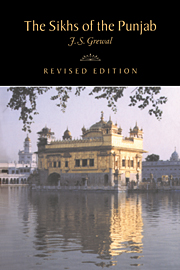Book contents
- Frontmatter
- Introduction
- 1 The Turko-Afghan Rule
- 2 Foundation of the Sikh Panth
- 3 Evolution of the Sikh Panth (1539–1606)
- 4 Transformation of the Sikh Panth (1606–1708)
- 5 Rise to political power (1708–1799)
- 6 The Sikh empire (1799–1849)
- 7 Recession and resurgence (1849–1919)
- 8 In the struggle for freedom (1920–1947)
- 9 Towards the ‘Punjabi Province’ (1947–1966)
- 10 In the new Punjab state (1966–1984)
- Bibliographical essay
- Index
- THE NEW CAMBRIDGE HISTORY OF INDIA
- References
1 - The Turko-Afghan Rule
Published online by Cambridge University Press: 28 March 2008
- Frontmatter
- Introduction
- 1 The Turko-Afghan Rule
- 2 Foundation of the Sikh Panth
- 3 Evolution of the Sikh Panth (1539–1606)
- 4 Transformation of the Sikh Panth (1606–1708)
- 5 Rise to political power (1708–1799)
- 6 The Sikh empire (1799–1849)
- 7 Recession and resurgence (1849–1919)
- 8 In the struggle for freedom (1920–1947)
- 9 Towards the ‘Punjabi Province’ (1947–1966)
- 10 In the new Punjab state (1966–1984)
- Bibliographical essay
- Index
- THE NEW CAMBRIDGE HISTORY OF INDIA
- References
Summary
Babur's invading army in the eyes of Guru Nanak was a ‘marriage-party of sin’. Not even the ladies of the nobles were spared dishonour. With heads once of luxuriant tresses and partings adorned with red, they suffered now the shears of brutality; their throats were filled with choking dust; they wandered forlorn, away from the places that had sheltered them. No longer were there the sports of the nobles themselves, and gone were their horses and stables, their trumpets and clarions, their scarlet tunics and sword belts, their mansions and palaces, and their seraglios with soft beds and ‘beautiful women whose sight banished sleep’. Rocklike buildings were razed to the ground and princes were trampled into dust. ‘It is Babur who rules in their place now’.
Guru Nanak's sharp response to Babur's invasions underlines the most important political development during his life, the transition from Afghan to Mughal rule in the Punjab and in northern India. The first fifty years of Guru Nanak's life had been marked by a period of peace in the Punjab. At the time of his birth in 1469 the Punjab was a part of the Sultanate of Delhi under Bahlol Lodhi. The major conquest of Bahlol and his successors was that of the Sharqi kingdom of Jaunpur. Their battles for minor political or territorial gains were fought in Rajasthan. There were only a few insignificant revolts in the Punjab during a period of about seventy years.
- Type
- Chapter
- Information
- The Sikhs of the Punjab , pp. 9 - 27Publisher: Cambridge University PressPrint publication year: 1991



